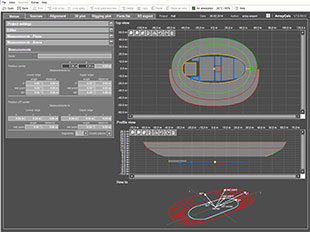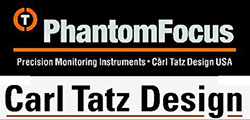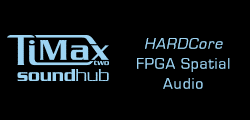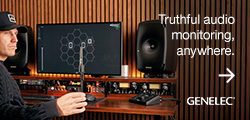d&b audiotechnik has released ArrayCalc v7.6 bring new features to its room simulation software, including improved room data input to define listening planes in three dimensions and support xC-Series column loudspeakers as well as the D80 amplifier. Export functions for the new d&b R1 Remote control software v2 are also provided.
 Now called Venue, the room input control allows a representation of the audience areas to be created in three dimensions. This includes typical listening planes, arenas, balconies, side stalls and 360° scenarios, even with curved edges. Additionally, the Arena measurement function builds a virtual model using dimensions determined with a distance and angle finder, meaning individual planes no longer have to be predefined for arena models.
Now called Venue, the room input control allows a representation of the audience areas to be created in three dimensions. This includes typical listening planes, arenas, balconies, side stalls and 360° scenarios, even with curved edges. Additionally, the Arena measurement function builds a virtual model using dimensions determined with a distance and angle finder, meaning individual planes no longer have to be predefined for arena models.
ArrayCalc allows precise initial simulations in the planning of systems, significantly reducing set-up and tuning time in mobile and installed applications. Up to 14 flown arrays or subwoofer columns can be defined in a project file. d&b line and point source loudspeakers are selectable and can be included as the application requires.
ArrayCalc simulates the direct sound performance of the system taking into account input level, all system configuration options (such as Arc, Line, CUT, CPL, HFC or Infra), limiter activity and air absorption. Acoustic shadowing caused by obstacles such as balcony overhangs or scoreboards can also be calculated.
Ground stacked Sub arrays with as many as 51 positions can be modelled, the horizontal dispersion for different LF bands is then displayed. To achieve the desired directivity, ArrayCalc provides the individual delay settings for the subwoofers. Arrival times and Sound Pressure Levels at a freely definable reference point on one of the audience listening areas is used to predetermine the time alignment and phase response between both flown and ground stacked sources. A comprehensive rigging plot with all necessary coordinates, dimensions and weights of arrays with a parts list of all loudspeakers and rigging components is generated for export and printing.
The load status of all rigging components is constantly monitored and displayed to determine whether a given array is within the SWL load tolerance.
The R1 export function produces a project file for the R1 Remote control software. Complete details of the system simulated in ArrayCalc are generated, including loudspeakers, amplifiers, remote IDs, groups and all configuration information..
More: www.dbaudio.com










